Welcome to DU!
The truly grassroots left-of-center political community where regular people, not algorithms, drive the discussions and set the standards.
Join the community:
Create a free account
Support DU (and get rid of ads!):
Become a Star Member
Latest Breaking News
Editorials & Other Articles
General Discussion
The DU Lounge
All Forums
Issue Forums
Culture Forums
Alliance Forums
Region Forums
Support Forums
Help & Search
Massachusetts
Related: About this forumMaps Reveal How Immigration Transformed Bostonís Neighborhoods
http://www.wired.com/wiredscience/2014/03/maps-immigration-boston/
A 1905 bird's eye view of Boston's harbor, the second busiest port of entry for new immigrants at the time. More than 530,000 people entered the U.S. here between 1900 and 1910. Norman B. Leventhal Map Center at the Boston Public Library
Maps Reveal How Immigration Transformed Boston’s Neighborhoods
By Greg Miller
03.21.14 8:00 AM
In 1910, Boston was the fifth biggest city in the United States, with a population just over 670,000. It was the second busiest port of entry for foreigners at the time, and 240,000 of its citizens were foreign born. A new exhibit at the Boston Public Library uses maps, modern and historic photos, and census data to illustrate how waves of immigration shaped the city and its individual neighborhoods in the 20th century — and continue to shape them today.
“The idea is to look at Boston as a whole, but then to zero in on certain neighborhoods and see what those stories are,” said Michelle LeBlanc, director of education at the library’s Norman B. Leventhal Map Center, which is hosting the exhibit. “It’s sort of a microcosm-macrocosm way of looking at the city.”
Boston is a smaller city today than it was a century ago, with a population of about 636,000 in 2012, according to the Census Bureau. But its population is rebounding after dipping below 563,000 in 1980. “Over the last 10 years Boston’s population has grown, and it’s largely just because of immigration,” LeBlanc said. “We would have lost population otherwise.”
The percentage of foreign-born residents is lower than it used to be: 27 percent, compared to 36 percent in 1910. But some neighborhoods are still remarkably diverse. East Boston’s population is almost 50 percent foreign born, the highest percentage of any neighborhood in the city.
--
The Boston Public Library is a marvelous resource. Did you know they have online photo collections?
http://www.flickr.com/photos/boston_public_library/collections/
http://www.flickr.com/photos/boston_public_library/sets/72157623742255962/#
March 5, 1770, marked a watershed moment in Massachusetts’ growing unrest and a major milestone in John Adams’ legal career. That evening, a local crowd converged on a small group of British soldiers in front of Boston’s Custom House. The townspeople pelted the redcoats with sticks, oyster shells, and snowballs, provoking the anxious soldiers to fire into the crowd, killing five colonists. Anger immediately swelled among the Bostonians. Publications soon proclaimed the event the “Boston Massacre,” and a war of propaganda raged between indignant colonists and British loyalists.
At the time of the Boston Massacre, Adams was one of Boston’s leading attorneys, and he maintained that the incident was a telling reminder of the dangers of standing armies. However, he also believed deeply in every citizen’s right to a fair trial. He did not hesitate when approached to take on the defense of the British troops, although he knew that his reputation and legal practice might suffer an irreparable blow. He stood firm on principle and deemed it “one of the most gallant, generous, manly and disinterested Actions of my whole Life, and one of the best Pieces of Service I ever rendered my Country.”
He scrawled these small journal pages of extremely detailed notes regarding eyewitness testimony during the trial proceedings and drew heavily from them in his summation. In his notes, he documented the list of witnesses and the “Evidence of Commotions that Evening,” including such particulars as “Ice & Snow Balls thrown, Sticks rattled upon their guns… Boys hove Pieces of Ice at Sentry as big as your fist, hard and large enough to hurt a Man.” Drawing upon both classical and contemporary precedents, Adams’ impassioned arguments for the natural right of self-defense had an “electric effect” on the courtroom and succeeded in winning the British soldiers’ freedom.
http://www.flickr.com/photos/boston_public_library/4479014301/in/set-72157623742255962
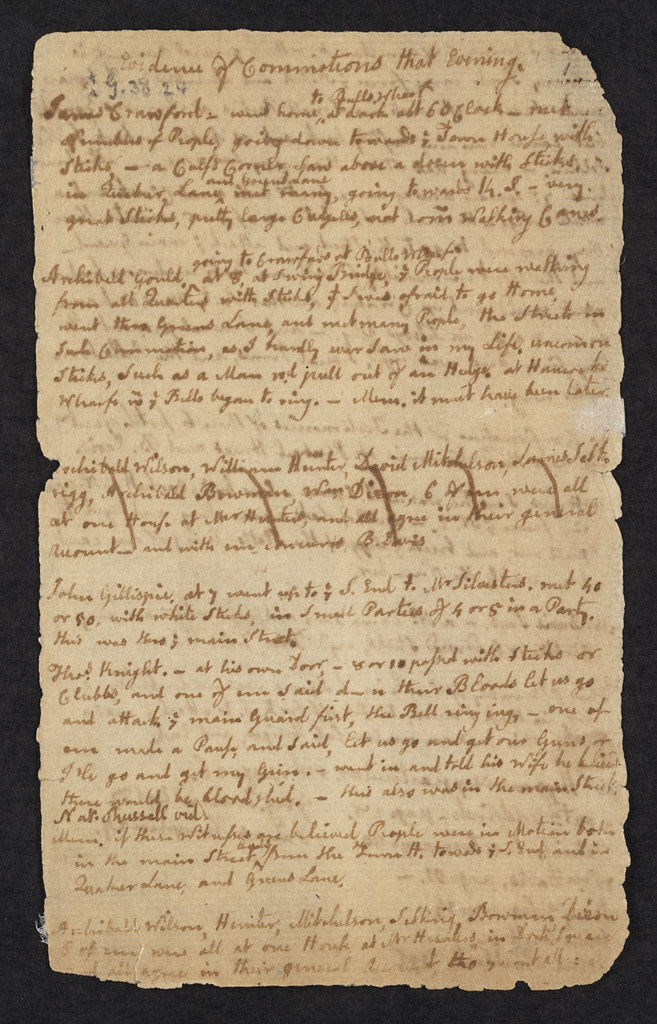

..
One more :
http://www.flickr.com/photos/boston_public_library/sets/72157624622085789/
The Boston Molasses Disaster, also known as the Great Molasses Flood, occurred on January 15, 1919, in Boston’s North End. The disaster occurred on an unusually warm day at the Purity Distilling Company when a large storage tank containing 2.3 million gallons of molasses burst. The collapse unleashed an immense wave of molasses fifteen feet high, moving at 35 miles an hour. Nearby buildings were swept off their foundations and several North End blocks were flooded to a depth of two to three feet. Nearly 150 people were injured and 21 people and several horses were killed in the disaster.
It took over 87,000 man hours to remove the molasses from the streets, theaters, businesses, automobiles, and homes. Boston Harbor was still brown with molasses until summer. Local residents brought a class-action lawsuit, one of the first held in Massachusetts, against the United States Industrial Alcohol Company (USIA), which had bought Purity Distilling in 1917. USIA ultimately paid out $600,000 in out-of-court settlements. The event has entered local folklore, and some residents claim that on hot summer days, the scent of molasses still hangs in the air.
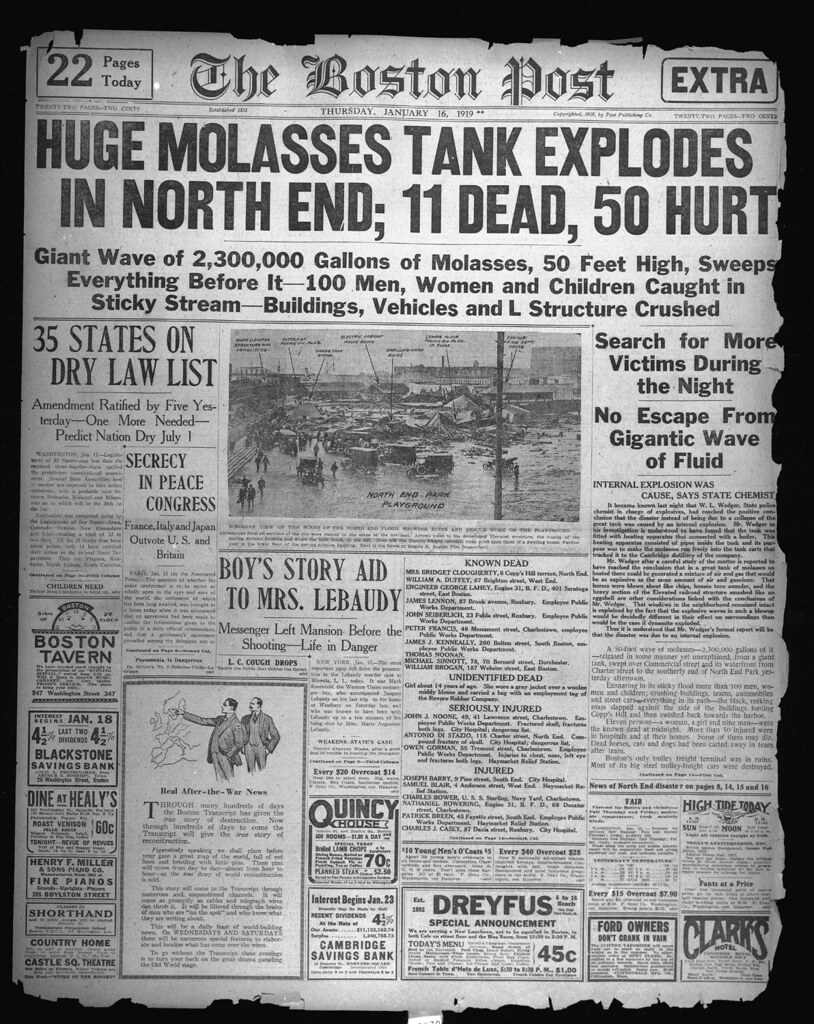
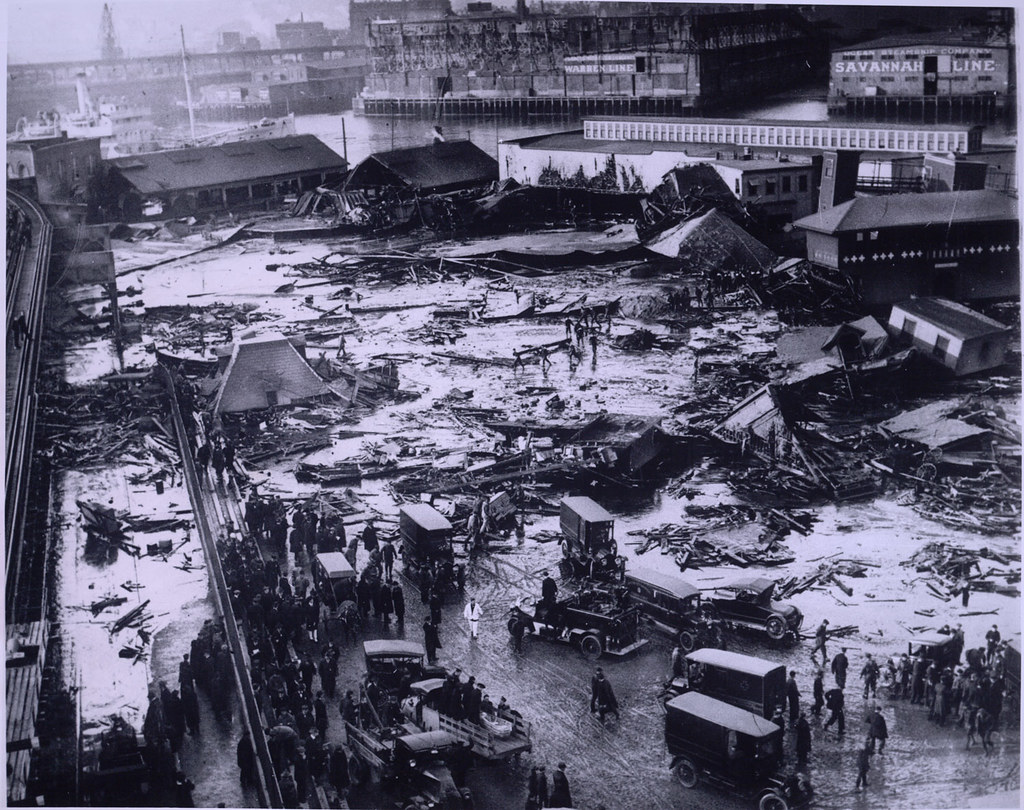
.
How cool is that?
InfoView thread info, including edit history
TrashPut this thread in your Trash Can (My DU » Trash Can)
BookmarkAdd this thread to your Bookmarks (My DU » Bookmarks)
4 replies, 3620 views
ShareGet links to this post and/or share on social media
AlertAlert this post for a rule violation
PowersThere are no powers you can use on this post
EditCannot edit other people's posts
ReplyReply to this post
EditCannot edit other people's posts
Rec (2)
ReplyReply to this post
4 replies
 = new reply since forum marked as read
Highlight:
NoneDon't highlight anything
5 newestHighlight 5 most recent replies
= new reply since forum marked as read
Highlight:
NoneDon't highlight anything
5 newestHighlight 5 most recent replies
Maps Reveal How Immigration Transformed Bostonís Neighborhoods (Original Post)
unhappycamper
Mar 2014
OP
MADem
(135,425 posts)1. Boston had a terrible fire in 1872 as well.
http://en.wikipedia.org/wiki/Great_Boston_Fire_of_1872


And then there was the Cocoanut Grove fire more recently in 1942...
http://en.wikipedia.org/wiki/Cocoanut_Grove_fire
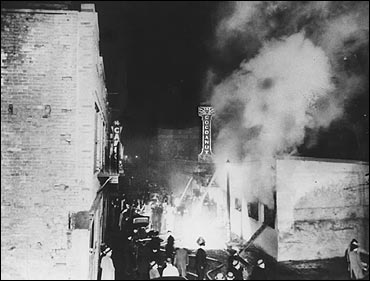
Notable events of the fire:
Author Oliver Wendell Holmes, Sr. watched the fire from his home on Beacon Hill. He wrote a poem about the event called "After the Fire".
Alexander Graham Bell wrote his own eyewitness account of the fire in a letter to the newspaper The Boston Globe. Unimpressed by Bell's prose, the paper did not publish his letter.
The Great Chicago Fire had occurred just one year earlier, in October 1871.
A committee of concerned citizens and property owners who were deputized to demolish buildings in the path of the fire with gunpowder kegs. The explosions did more harm than good by most accounts.
The glow in the sky over the fire was noted in ship's logs off the coast of Maine.
Fire departments from every state in New England, except Vermont, arrived on trains carrying pumpers, fire fighters and more spectators.
Of these were two Amoskeag Steamers from Manchester, New Hampshire. One was the first Amoskeag ever constructed (Serial number 1), owned by the Manchester Fire Department; the other was the first self-propelled Amoskeag that the manufacturer sent down. Boston purchased the self-propelled steamer after the fire, impressed with its performance. The self-propelled steamer was the first one in use in the country.[2]
Looters had to be chased out of burning buildings.
Old South Meeting House on Washington Street, the church in which the Boston Tea Revolt was organized, was rescued from the fire by a citizens' brigade of wet blankets[citation needed] as well as the Kearsarge Steam Fire Engine from Portsmouth, New Hampshire....
Author Oliver Wendell Holmes, Sr. watched the fire from his home on Beacon Hill. He wrote a poem about the event called "After the Fire".
Alexander Graham Bell wrote his own eyewitness account of the fire in a letter to the newspaper The Boston Globe. Unimpressed by Bell's prose, the paper did not publish his letter.
The Great Chicago Fire had occurred just one year earlier, in October 1871.
A committee of concerned citizens and property owners who were deputized to demolish buildings in the path of the fire with gunpowder kegs. The explosions did more harm than good by most accounts.
The glow in the sky over the fire was noted in ship's logs off the coast of Maine.
Fire departments from every state in New England, except Vermont, arrived on trains carrying pumpers, fire fighters and more spectators.
Of these were two Amoskeag Steamers from Manchester, New Hampshire. One was the first Amoskeag ever constructed (Serial number 1), owned by the Manchester Fire Department; the other was the first self-propelled Amoskeag that the manufacturer sent down. Boston purchased the self-propelled steamer after the fire, impressed with its performance. The self-propelled steamer was the first one in use in the country.[2]
Looters had to be chased out of burning buildings.
Old South Meeting House on Washington Street, the church in which the Boston Tea Revolt was organized, was rescued from the fire by a citizens' brigade of wet blankets[citation needed] as well as the Kearsarge Steam Fire Engine from Portsmouth, New Hampshire....


And then there was the Cocoanut Grove fire more recently in 1942...
http://en.wikipedia.org/wiki/Cocoanut_Grove_fire
The Cocoanut Grove was Boston's premier nightclub during the post-Prohibition 1930s and 1940s. On November 28, 1942, this club was the scene of the deadliest nightclub fire in history,[1] killing 492 people (which was 32 more than the building's authorized capacity) and injuring hundreds more. The enormity of the tragedy shocked the nation and briefly replaced the events of World War II in newspaper headlines. It led to a reform of safety standards and codes across the country, and major changes in the treatment and rehabilitation of burn victims.

unhappycamper
(60,364 posts)2. Boston looked like Hiroshima after the 1872 fire
http://www.flickr.com/photos/boston_public_library/sets/72157624805421584/
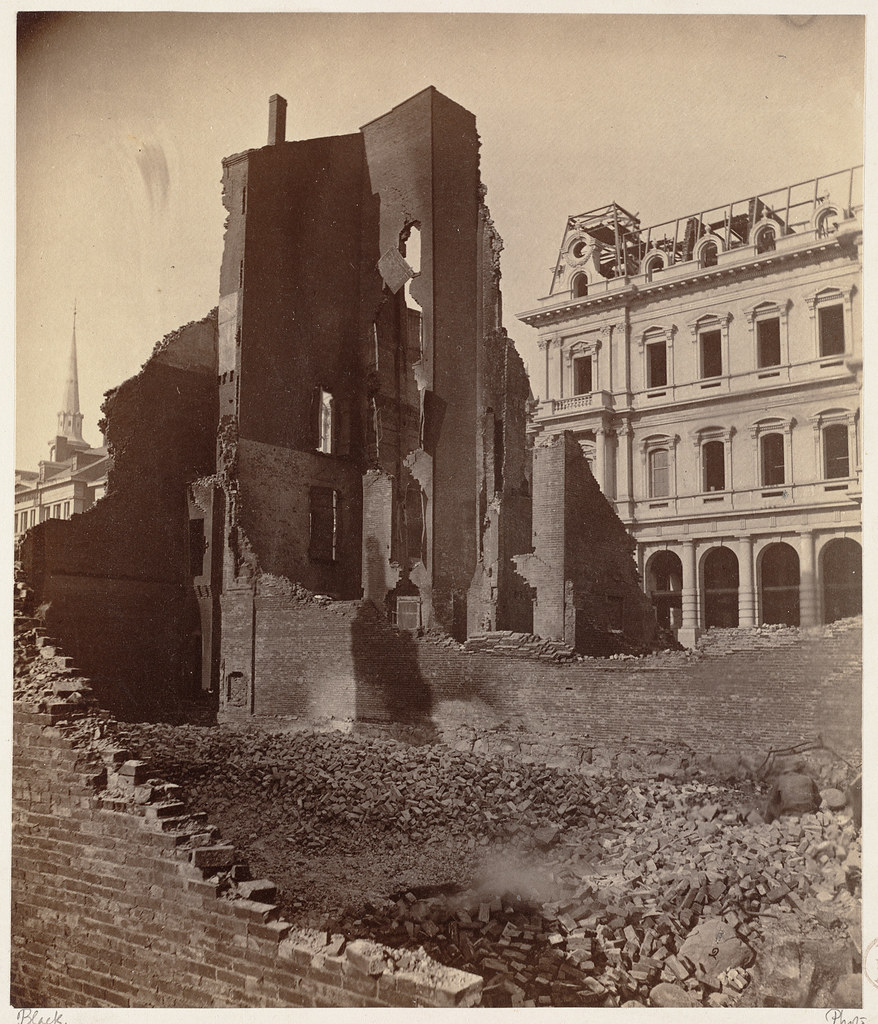
South Side Milk St.
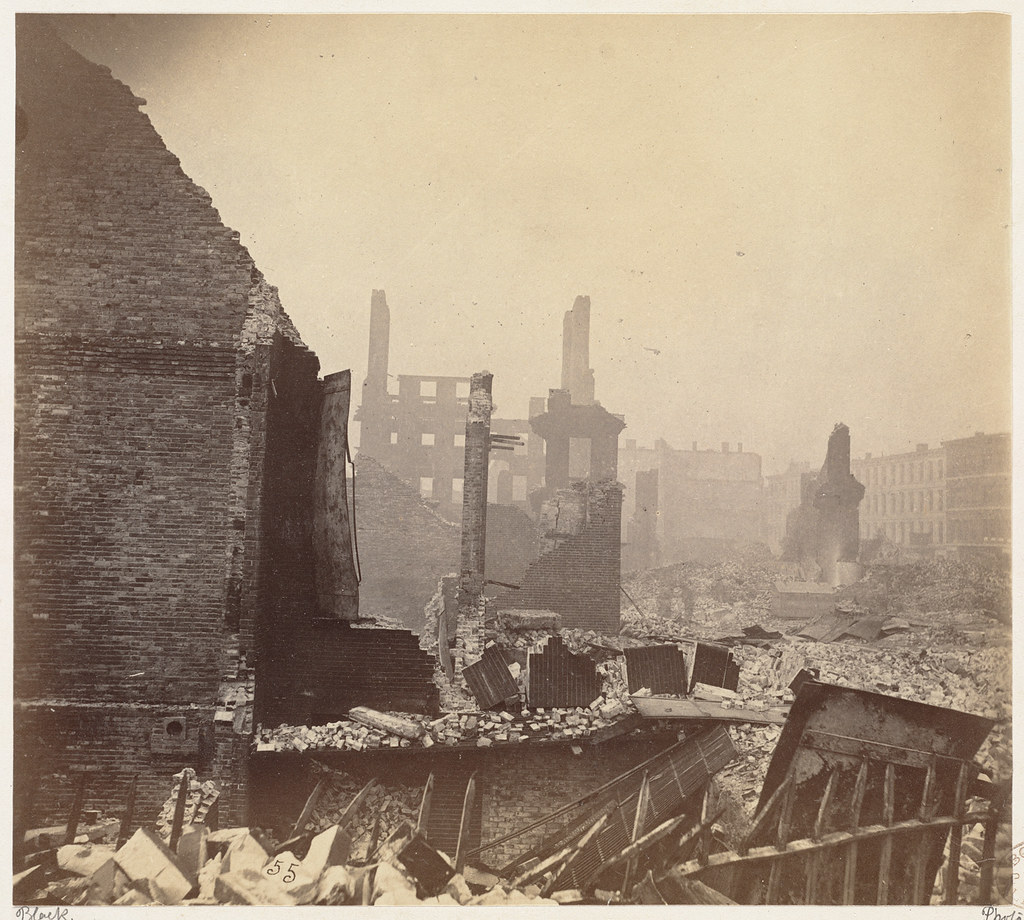
High St. to Milk St.

South Side Milk St.

High St. to Milk St.
MADem
(135,425 posts)3. Yes it could have taken out the State House if the wind had been right.
It was a miracle that some of our most important historical treasures were spared!
4Q2u2
(1,406 posts)4. No it is not the Wild West of Texas